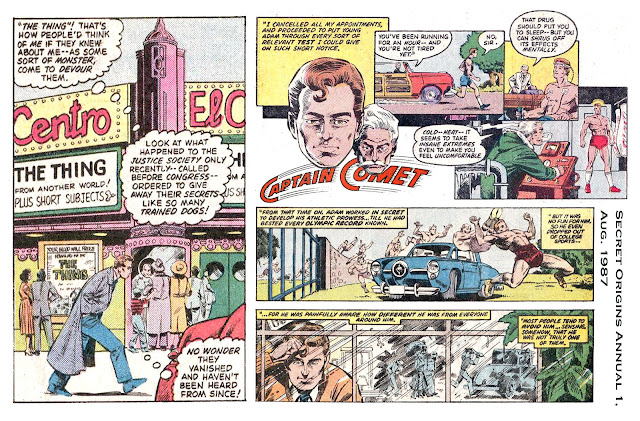October 1954: Comet at Twilight
In Captain Comet’s final adventure
of the 1950s, the fictional futuristic man faces off against a symbol of
society’s actual future — the
computer.
Or so it seems.
In The Revolt of the Thinking Machine (Strange Adventures 49, Oct.
1954), the Man of Destiny
communicates the history of what he presciently says may be his “final battle”
to Prof. Zackro through the professor’s TV.
As newsboys shout that a Midwest
University “thinking machine” has locked out the scientists who built it,
Captain Comet tells Zackro, “I got to the Physics Building, of course, only
moments after the story got out…”
Communicating through a typewriter,
the “giant calculator” warns, “No one must interfere with what I am doing! If
anyone forces his way into the room, I shall destroy him!”
The Man of 100,000 A.D. does just
that as the machine blasts him with electric energy. “The bolts, of course, had
no effect on me!” Comet tells Zackro. “My unique body instantly set up an
immunity to the powerful charges.”
Stymied, the computer reveals that
it had been building a cobalt bomb.
“I detected the presence on Earth
of creatures unhuman and with weapons
unearthly!” the computer tells Comet.
“It was to combat the terrible threat of these aliens that I began to build the
bomb. The aliens are in a section of the western desert, preparing for the
attacks! My bomb could have stopped them, but now…”
The overstrained computer goes
dead, with the bomb uncompleted.
So John Broome’s tale, drawn by Sy
Barry, turns out to be a reverse-Frankenstein
story, with the seemingly menacing creation actually working to defend
humanity, not to harm it. It’s a theme familiar from 1940s science fiction,
notably Isaac Asimov’s robot stories and Earl and Otto Binder’s Adam Link adventures.
This is another of those Broome
stories in which something inhuman turns out to be surprisingly “humane,” with
the supercomputer sacrificing itself to save us. Broome would return to that
theme again in his later Green Lantern stories.
“It would take me too long to
complete this cobalt bomb that the machine started to build!” Comet thinks.
“I’ll have to handle the invaders in my own way — and at once!”
Rocketing to the west at
spectrum-speed, the superhero telecasts his situation to Zackro, noting that
through telepathic analysis he’d determined that “…the creatures down there —
from a far-off star — are immune to all poison gases and explosive weapons!”
Flying to a huge irrigation dam in
the mountains overlooking the desert, the Earth champion opened the floodgates.
“Elgni! Water! Someone has
discovered our secret!” one of the aliens shouts. “Abandon all equipment! Into
the ship! Quickly — before our very lives are lost!”
As the invaders’ ship rockets away
from the planet, Captain Comet reveals to Zackro that he had telepathically
determined that the aliens had located their base in a desert because they were
life forms based on sodium chloride.
“Yes, professor! They were soluble in water — just like sodium
chloride, or common table salt is. No doubt they hoped to conquer us before we
found out their weakness!”
It’s an Achilles’ heel the
invaders would share with the aliens in M. Night Shyamalan’s 2002 film Signs — and with the Wicked Witch of the
West, for that matter.
Meanwhile, back at Midwest
University and none the wiser, the physicists have their supercomputer back in
operation.
“It’s working again — and
obediently!” a bow-tied scientist tells the superhero. “I’m beginning to think
what happened was just an accident!
After all, a machine can’t act on its own!”
Captain Comet knows differently,
but keeps quiet, thinking, “But it did
— and helped save the Earth!”
Captain Comet himself would stay
out of sight until 1976 when, now a man out of his time like Captain America,
he returned to Earth to infiltrate The
Secret Society of Super Villains.
Yet soon after Comet’s
disappearance, DC would effectively retool, recycle and reverse the concept.
Instead of sending a telepathic, telekinetic human into space for heroics,
they’d bring a telepathic, telekinetic alien to Earth for undercover derring-do
in, of all things, Detective Comics.
The Martian Manhunter — debuting
in Detective Comics 225 (Nov. 1955)
and going on to help found the Justice League — would even be vulnerable to
fire, like the Erotian invaders in Eyes
of Other Worlds.
The concept of super powers would
continue to intrigue comic book readers throughout the 1950s, often without
being linked to superheroes. The cover story of Captain Comet’s last issue, for
example, was The Brain Giants, and
featured three suited-and-tied men raising a 2,000 pound-weight with their
minds.
Strange Adventures was my favorite non-superhero title as a child,
and I’d have been thrilled to know that a superhero had once starred in it. But
I had the advantage of enjoying the title in its most polished period, an era
in which it caught the streamlined, jet-age zeitgeist.
I’d argue that the best and
sunniest issues of the title were published from 1955 through 1963. In Strange Adventures, children would find
a satisfying reflection of the scientific and social optimism implied in JFK’s
“New Frontier.”





Comments
Post a Comment